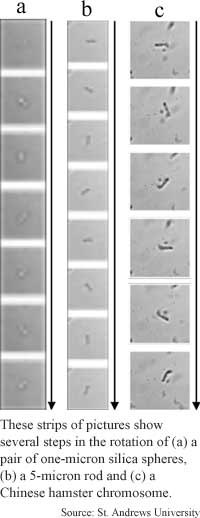
Lasers
spin microscopic objects
By
Kimberly Patch,
Technology Research NewsA group of scientists from St. Andrews University in Scotland have found a way to rotate microscopic objects using the interference pattern produced by two laser beams.
The method, which allows the researchers to closely control how quickly an object spins, could prove useful in developing new rotational elements for micromachines and should make it easier for biologists to study the effects of rotational forces on large molecules.
The method works because objects as small as a few microns are largely transparent to light, and when lightwaves pass through an object, the lightwaves bend. The equal and opposite force required to counteract the bend isn't something that makes much difference at the macro level, but it is enough to move micron-size objects. A micron is one-thousandth of a millimeter; an E. coli bacteria is about two microns long and one micron in diameter.
Using lasers to trap and move small objects is something scientists regularly do.
The researchers' key idea was to use the interference pattern of two light beams to rotate the objects.
They used an interferometer to split a beam of light, then changed the phases of the beams so the beams interfered with one another in a certain pattern when recombined. "The idea is to use a special combination of two light beams that results in a spiral [wave] pattern," said Kishan Dholakia, a lecturer at St. Andrews University in Scotland. "By varying one of the light beams we can cause the pattern to rotate. The particles are trapped in the bright regions of the pattern -- the spiral arms -- and rotate too," he said.
Because the method is relatively simple, it is easy to control, allowing the researchers to rotate tiny objects at different speeds. "We can control the pattern rotation exactly and therefore the rotation of the particles with high precision," said Dholakia.
The researchers have used the method to set microscopic glass rods, chromosomes and clusters of silica microspheres spinning from one to five hertz, or rotations per second. The glass rods were five microns long and the sphere clusters ranged in length from one to five microns. A single chromosome weighs about one millionth of one millionth of a gram.
"So far we have only a very basic set up to demonstrate that the idea works, but... rotation rates of several tens or even hundreds of hertz should be easily obtainable," said Jochen Arlt, a research fellow at St. Andrews University in Scotland.
The researchers "have devised a very elegant method of rotating a wide variety of micron-sized objects [optically]," said Chris Meiners, an assistant professor at the University of Michigan. "It's beauty lies in the use of a helical interference pattern as [a] force generating field that can be rotated simply by changing the phase in one of the interferometer arms," he said.
The technique "promises to be very useful [because] it can be used to rotate virtually any nonspherical object that can be optically trapped," he said. This would allow microelectromechanical systems researchers to more easily develop tiny rotors, he said. The technique itself is not likely to be used in micro mechanical products, however because the system -- with the laser, interferometer and microscope -- is too complex and bulky, he added.
The method also has potential biological uses, Meiners said. "I think we will soon see single molecule experiments using it to study biological macromolecules under an applied torque," he said. Until now, optical trapping techniques have allowed biologists to study molecules like DNA by applying and measuring the effects of linear forces, but there have been few experiments studying the equally important effects of rotational forces because rotating molecules is difficult, said Meiners.
The researchers plan to further develop the method for both micromachine and biological applications, said Dholakia. The method should work well with biological objects because "many biological things are transparent at some wavelength, and one can even attach transparent beads... to help," he said. Possible biological applications include orienting biological objects to get active sites to latch onto one another, and microstirrers that mix things on a microscopic scale, he said.
The method could be applied practically in less than two years, said Arlt.
Arlt and Dholakia's research colleagues were Lynn Paterson, Michael P. McDonald, Wilson Sibbett and Peter E. Bryant. They published the research in the May 4, 2001 issue of the journal Science. The research was funded by The UK Engineering and Physical Sciences Research Council.
Timeline: < 2 years
Funding: Government
TRN Categories: Materials Science and Engineering; Optical Computing, Optoelectronics and Photonics
Story Type: News
Related Elements: Technical paper, "Controlled Rotation of Optically Trapped Microscopic Particles," Science, May 4, 2001.
Advertisements:
May 23, 2001
Page One
Laser switch sets up logic
Light computer runs quantum algorithm
Five percent of nodes keep Net together
Prototype shows electronic paper potential
Lasers spin microscopic objects

News:
Research News Roundup
Research Watch blog
Features:
View from the High Ground Q&A
How It Works
RSS Feeds:
News
Ad links:
Buy an ad link
| Advertisements:
|
 |
Ad links: Clear History
Buy an ad link
|
TRN
Newswire and Headline Feeds for Web sites
|
© Copyright Technology Research News, LLC 2000-2006. All rights reserved.